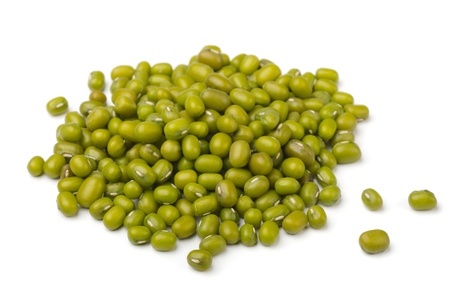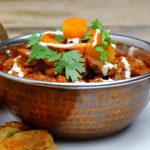
Mung beans and mung bean sprouts (Vigna radiata (L.) Wilczek) are one of those foods which should be more widely eaten. They are in the same league as peas, other beans and lentils which are developing their own health story. The main issue is their lack of popularity with foodies given that other beans like chickpeas have overtaken them in popularity. In India however, they have been consumed for centuries and are viewed as “one of the most cherished foods”. In truth you can find them in all sorts of guises in Asian cuisine.
Description Of The Mung Bean Plant
The plant is erect or sub-erect, creeping or twining annual herb which grows up to 30–90 cm high. The plant has branched, weak, trailing and climbing stem of 5 m to 3 m long. The plant has deep rooted system with nitrogen fixing nodules. The season of the fruit and seeds is from summer to fall.
Plants have trifoliate alternate leaves with elliptical-ovate leaflets. The leaves can grow up to 5-18 cm long and 3-15 cm broad.
Mung beans produce yellow flowers typical of legumes and are followed by long and cylindrical pods. These flowers develop into pendant, linear-cylindrical pods between 4–12 cm long and 4–6 mm broad. The pods are black, brown and pale gray in colour. Each pod contains small sub-globose or ellipsoid shaped beans. The seeds are ellipsoid up to 4–6 mm and appear in a variety of colours such as yellow, greenish-yellow, light green, dark green, shiny green, dull green, brown, black and green often mottled with black.
The seeds have lustrous and unpolished dark green skin with light yellow flesh. The seed flavours vary between sweet and savoury.
Nutritional Content Of Mung Bean
Mung beans are simply tiny, green legumes full of protein, vitamins, fibre, various phytonutrients and other goodies like antioxidants.
-protein content is 24-28% w/w (Li et al., 2010). The main protein is the 8S globulin known as vicilin and makes up 89% of the total globulin. The other globulin proteins are the 7S and 11S (Mendoza et al., 2001).
– high levels of various branched amino acids (BCAAs) include leucine, isoleucine and valine which compare favourably with a FAO/WHO reference protein (Mubarak, 2005).
Perhaps the most important feature is their richness in total phenolics as measured using the DPPH free radical scavenging assay (Yao et al., 2011). Mung bean hulls (the immature seed coating) also contains condensed tannins, vitexin, isovitexin, various saponins as well as total phenolics and this is where much of the antioxidant activity comes from compared to the rest of the bean (cotyledon included) (Huang et al., 2014).
In terms of minerals and vitamins they contain magnesium, folate, copper, manganese, potassium, zinc and assorted B vitamins.
Germination of mung beans leads to a dramatic increase in vitamin C as well as various phenolics, flavonoids and their total antioxidant activity (Gan et al., 2016).
Use In Product Development
What versatility! We have used mung beans in soup mixes, protein powders and various recipes for ready meals. They have a filling and satiety effect which means they are effective ingredients for weight management products too.
If you leave them moistened and in the dark they become bean sprouts; skinned and split and you have a yellow moong dal; skinned, cooked and mashed and they become bean paste. Even the mung bean starch when its extracted can be used to make cellophane noodles and a jelly.
So, most mung beans are available dried which means they need soaking before cooking. If you eat whole, they have a creamy texture with a flavour somewhere between a lentil and garden pea. When sweetened they make that classic paste found in so many Japanese and Korean sweets.
Clinical Studies
-
Cholesterol Lowering Benefits
A small study found that mung beans are good for reducing levels of LDL cholesterol because the high levels of antioxidants appear to reduce inhibit their oxidation.
Products Available
This post contains links to our affiliate partnering partners. Please read our affiliate disclosure.
References
Gan, R.-Y., Wang, M.-F., Lui, W.-Y., Wu, K. & Corke, H. (2016). Dynamic changes in phytochemical composition and antioxidant capacity in green and black mung bean (Vigna radiata) sprouts. International Journal of Food Science & Technology, 51, pp. 2090–2098
Huang, X., Cai, W. & Xu, B. (2014). Kinetic changes of nutrients and antioxidant capacities of germinated soybean (Glycine max L.) and mung bean (Vigna radiata L.) with germination time. Food Chemistry, 143, pp. 268–276
Li, W.H., Shu, C., Yan, S.Q. & Shen, Q. (2010). Characteristics of sixteen mung bean cultivars and their protein isolates. International Journal of Food Science and Technology, 45, pp. 1205–1211
Luo, J., Cai, W., Wu, T. & Xu, B. (2016). Phytochemical distribution in hull and cotyledon of adzuki bean (Vigna angularis L.) and mung bean (Vigna radiate L.), and their contribution to antioxidant, anti-inflammatory and anti-diabetic activities. Food Chemistry, 201, pp. 350–360
Mendoza, E.M.T., Adachi, M., Bernardo, A.E.N. & Utsumi, S. (2001). Mungbean (Vigna radiata (L.) Wilczek) globulins: purification and characterization. Journal of Agricultural and Food Chemistry, 49, pp. 1552–1558
Mubarak, A.E. (2005). Nutritional composition and antinutritional factors of mung bean seeds (Phaseolus aureus) as affected by some home traditional processes. Food Chemistry, 89, pp. 489–495
Wang, J., Ye, Y., Li, Q., Abbasi, A. M. and Guo, X. (2017), Assessment of phytochemicals, enzymatic and antioxidant activities in germinated mung bean (Vigna radiata L. Wilezek). Int. J. Food Sci. Technol. 52 pp. 1276–1282. doi:10.1111/ijfs.13418
Yao, Y., Cheng, X., Wang, L., Wang, S. & Ren, G. (2011). Biological potential of sixteen legumes in China. International Journal of Molecular Sciences, 12, pp. 7048–7058.

I think this type of nutrient information is really good to know about. They make great sprouts as well. I am never disappointed by these foods. Great vegan fare and very healthy for you. Thanks for posting.